Key takeaways:
- Experiential learning fosters creativity and problem-solving by allowing learners to engage in hands-on activities that simulate real-life challenges.
- Simulations encourage collaboration, empathy, and adaptability among participants, enhancing the learning experience through shared challenges and diverse perspectives.
- Clear objectives and authentic scenarios are crucial in designing effective simulation activities, supporting greater engagement and meaningful reflection.
- Ongoing feedback within simulations helps students adjust strategies and promotes ownership of their learning process.
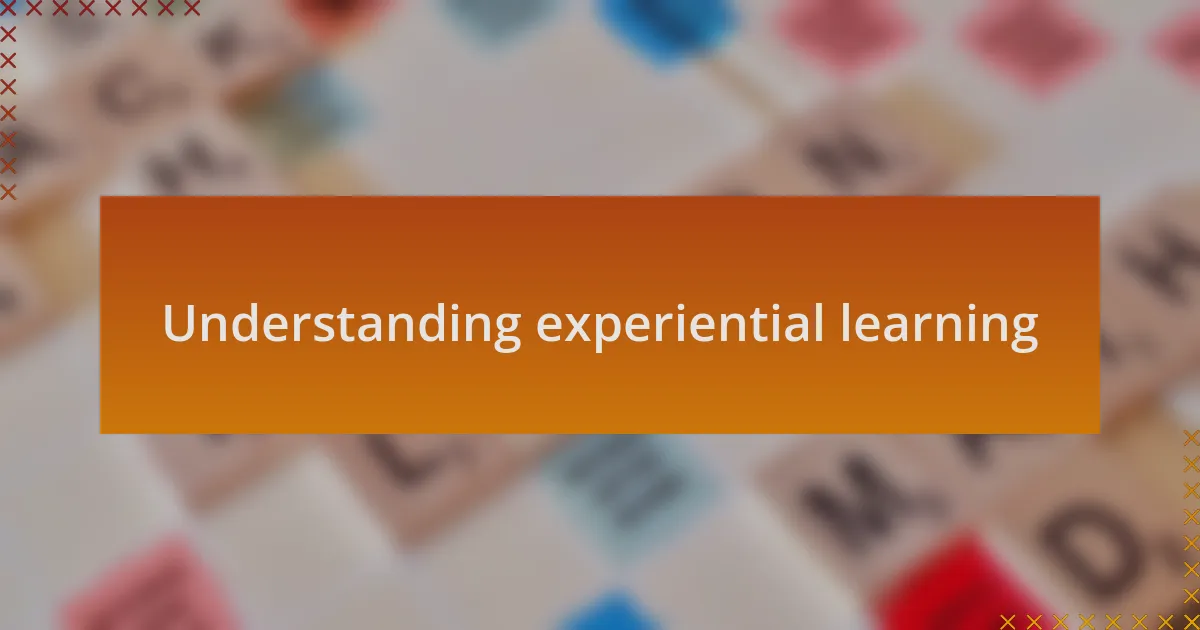
Understanding experiential learning
Experiential learning is this fascinating process where we learn by doing rather than just listening or reading. I remember a workshop where we had to build a bridge using only limited materials. The tension in the room was palpable as we brainstormed solutions together, which made me realize that hands-on experiences can ignite creativity in ways that lectures simply cannot.
One of the most impactful aspects of experiential learning is how it often mirrors real-life situations. When faced with a challenge, like that bridge-building task, we had to think on our feet and adapt. Wouldn’t you agree that some of our best ideas often come from moments of uncertainty? In my experience, stepping into the unknown brings out a level of creativity that polished presentations and theory simply cannot match.
Through these engaging learning experiences, I’ve grown to understand that mistakes are part of the journey. In fact, I’ve found that the best insights often come from the unexpected turns we encounter. Isn’t it refreshing to know that embracing the messiness of learning leads to greater creativity and innovation? That’s the beauty of experiential learning—we not only gain knowledge, but we also cultivate resilience and adaptability along the way.

Importance of creativity in learning
Creativity is the engine that drives effective learning. I vividly recall a session where we had to create a marketing campaign on the spot. The exhilaration of brainstorming with my peers sparked ideas that none of us would have conceived individually. Isn’t it incredible how creativity can transform a mundane task into an exciting challenge?
In my experience, fostering creativity in learning encourages students to become more engaged and invested in their education. I once facilitated a group project where students could choose their own topics. The energy shifted drastically; suddenly, they were not just participants but passionate creators. Does it surprise you how enthusiasm can elevate the quality of learning?
Moreover, creativity nurtures critical thinking and problem-solving skills. I’ve seen how students who embrace creative approaches are not only able to generate ideas but also analyze them from various angles. I often ponder whether traditional methods of education can fully cultivate these abilities. Isn’t it time we recognize that creativity isn’t just a bonus in learning—it’s essential?
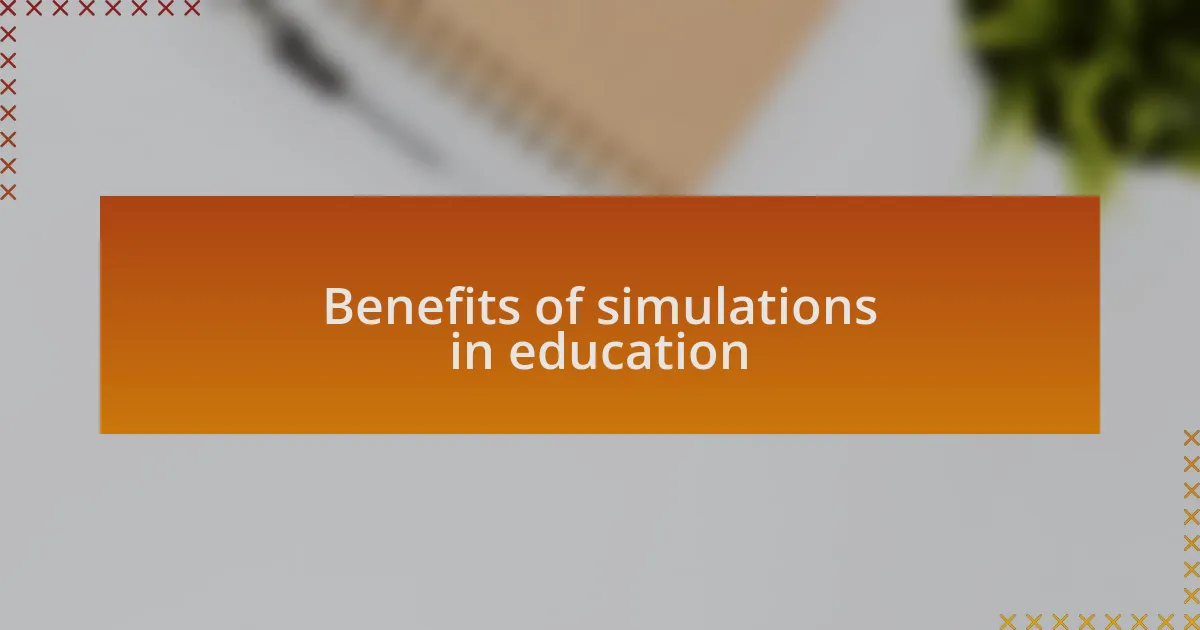
Benefits of simulations in education
Simulations in education offer a dynamic way to immerse students in real-world scenarios, fostering deeper understanding. I remember when I participated in a simulated business negotiation; the hands-on experience allowed me to grasp complex concepts like strategy and communication effectively. Isn’t it fascinating how stepping into a role can sharpen our critical thinking and decision-making skills?
Through my experiences, I’ve observed that simulations encourage collaboration among students. In one instance, I guided a group through a simulated environmental crisis. Each student assumed a role, and the collaborative dialogue erupted into a lively discussion that highlighted diverse perspectives. Have you ever seen how teamwork in simulations can lead to innovative solutions?
Furthermore, simulations create a safe space for experimentation and failure, which is crucial for learning. I once witnessed a student completely misinterpret a scenario during a simulation, but instead of feeling pressured, they embraced the mistake as a learning opportunity. Isn’t it liberating to know that in education, we can learn from our missteps and grow stronger?
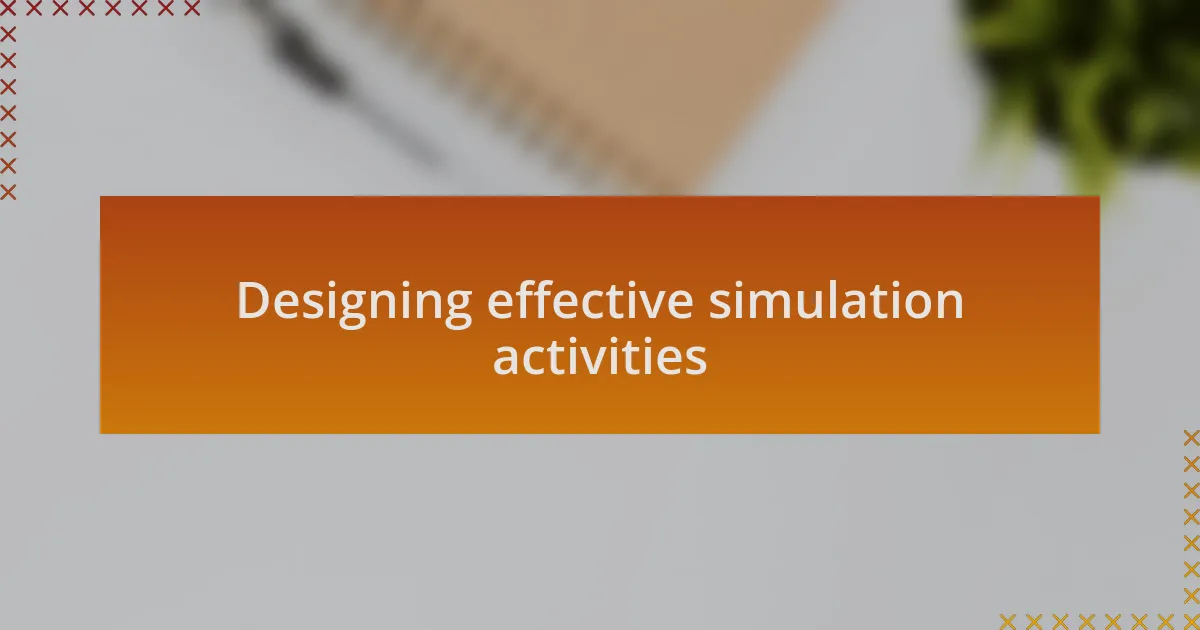
Designing effective simulation activities
Designing effective simulation activities starts with clear objectives. I always begin by outlining what skills or concepts I want participants to learn or practice. For instance, in a recent simulation focusing on project management, I specified that the goal was to enhance communication and delegation skills. This clarity guided every aspect of the design, influencing the roles, scenarios, and feedback mechanisms I incorporated.
Another vital aspect is realism. When I crafted a healthcare simulation, I infused authentic elements, like real patient cases and medical jargon, to make the experience relatable. The participants’ excitement was palpable as they engaged with the lifelike scenarios. Have you ever noticed how authenticity can elevate engagement and drive student investment in a learning activity?
Lastly, debriefing is crucial after a simulation. I’ve found that this reflective pause allows participants to process their experiences and solidify their learning. In one activity, we held a debriefing session that turned into a heartfelt discussion about the emotional impact of decision-making. It really highlighted for me how important it is to create space for reflection and connection after intense experiences. Don’t you think that the most profound learning often comes from these moments of vulnerability?

Implementing simulations in the classroom
Implementing simulations in the classroom requires intentionality and adaptability. I remember my first time introducing a business simulation; it was exhilarating yet nerve-wracking. The students were skeptical at first, but once they rolled up their sleeves and got involved, their curiosity and competitive spirit transformed the room. Doesn’t it astound you how a simple shift in approach can ignite a spark of ambition and creativity?
One critical aspect to consider is how students engage with their roles. When I assigned specific characters based on real-world profiles in a historical simulation, I was surprised by how deeply students connected with their roles. This emotional investment not only made the scenarios more immersive but also fostered empathy as they began to grapple with the perspectives of others. Have you ever thought about how stepping into someone else’s shoes can enrich understanding and collaboration?
Moreover, ongoing feedback throughout the simulation is essential for fostering creativity. I’ve implemented “check-in” moments during activities, allowing students to reflect on their strategies in real time. This approach creates a dynamic learning environment and encourages students to adjust their tactics based on peer discussions. Isn’t it fascinating how simultaneous feedback can empower students to take ownership of their learning journey?
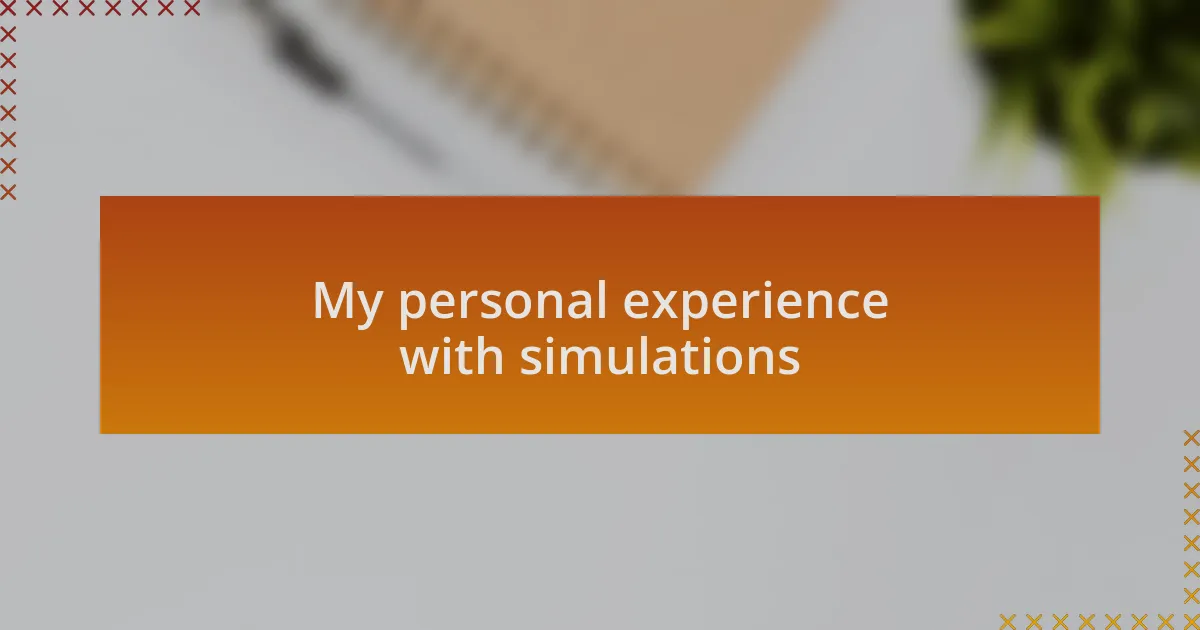
My personal experience with simulations
When I reflect on my experience with simulations, one particular instance stands out. We were immersed in a global crisis simulation, and I watched as students transformed before my eyes. Their initial hesitance faded, replaced by energy and creativity as they brainstormed solutions, often at unexpected angles. Isn’t it incredible how real-world stakes can drive imaginative thought?
One moment that resonated with me was when a student suggested an unconventional approach that merged two opposing ideas. It took courage to voice that thought, yet it sparked a heated discussion that led to a breakthrough in strategy. I was reminded of the power of a safe space where risks can be taken without fear of failure. How often do we encourage such environments in our daily lives?
As the simulation progressed, I began to notice the unexpected connections students formed with one another. They were no longer just classmates; they were collaborators, drawn together by a shared purpose. Witnessing this camaraderie and creativity blossoming was one of the most fulfilling moments of my teaching career. Have you ever experienced the magic that happens when people come together to solve a challenge? It’s something truly special.
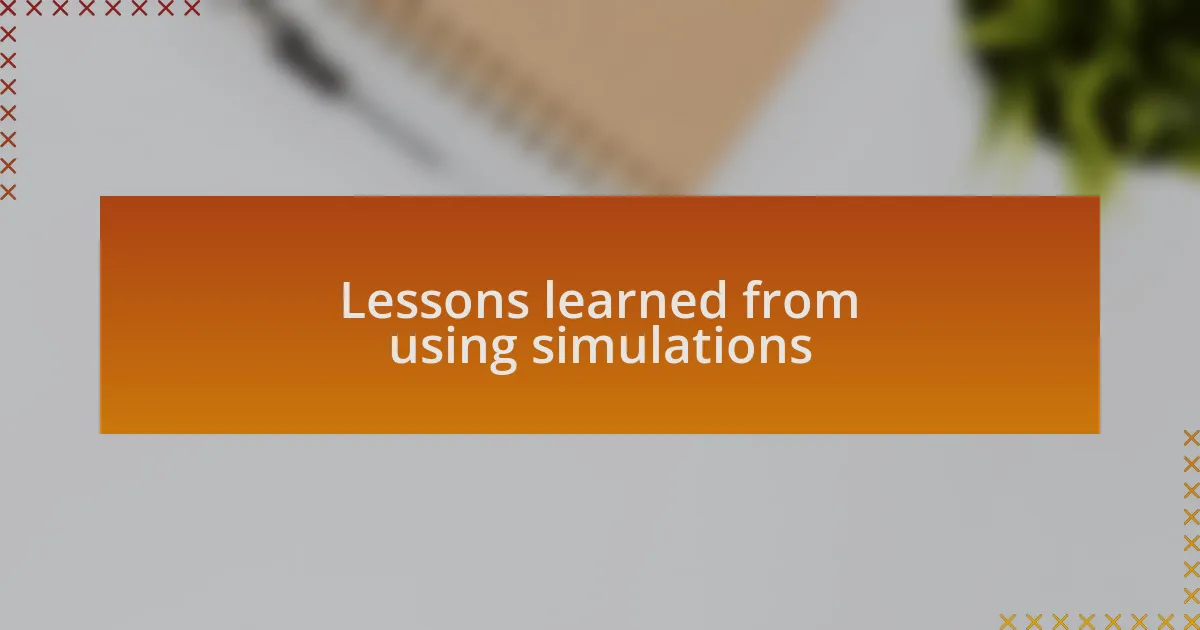
Lessons learned from using simulations
One of the most surprising lessons I learned from using simulations is the sheer power of perspective. During a simulation on resource management, students often stepped into roles they initially deemed unfamiliar. I vividly recall one participant claiming they had no experience, yet they ended up crafting innovative solutions that drew from their unique viewpoints. Why is it that we often underestimate our own abilities? This experience taught me that simulations can ignite hidden strengths, encouraging participants to explore new dimensions of their creativity.
Another significant takeaway was the importance of adaptability. During a health crisis simulation, unexpected scenarios forced our group to pivot quickly. I remember feeling a rush of adrenaline as students scrambled to revise their strategies on the fly. It was a palpable reminder that creativity often flourishes when we embrace uncertainty. How can we replicate that sense of urgency outside the simulation environment? I believe that fostering a culture of adaptability is vital, as it helps individuals thrive in unpredictable situations.
Finally, the collaborative spirit that emerged from these simulations was nothing short of incredible. While facilitating a team-focused scenario, I could see how failures turned into learning moments. When one strategy fell flat, rather than retreating, students rallied together, brainstorming fresh ideas with renewed enthusiasm. This camaraderie showcased how shared struggles can bring people closer. Isn’t it fascinating how collective challenges can build not just knowledge, but relationships too? Through simulations, I discovered that the essence of creativity lies not just in individual ideas, but also in the synergy generated through teamwork.